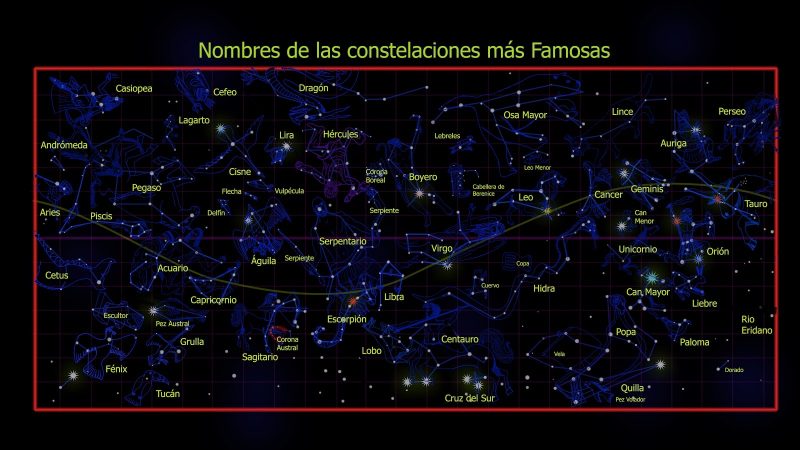[ad_1]
A constellation It is a grouping of stars that, when drawing a line that unites them in an imaginary way, forms a figure in the sky. The constellations form figures of people, gods, objects or animals and were useful for navigation in ancient times, since ships used them to guide themselves and know where they were. Some examples of constellations are: the constellation Ursa Major, the constellation Ursa Minor and the constellation Virgo.
The junction between points that form a constellation is arbitrary, that is, it does not respond to a specific astronomical question but to a human criterion. However, the constellations became a fundamental part of the astronomical communication of ancient civilizations.
The ancient peoples who made the first annotations above the constellations were the civilizations of the Middle East and those of the Mediterranean. Many constellations were identified by a certain civilization, which did not mean that other peoples recognized them. There are the constellations of the Chinese, pre-Columbian, and Hindu people, among others. Currently, the IAU (International Astronomical Union) recognizes 88 modern constellations.
The constellations can be observed directly when looking at the night sky, they are always in the same position and are more clearly seen in areas of low concentration of artificial lights and pollution. Although the stars that make up the same constellation seem to be at a short distance, the truth is that they can be found millions of kilometers from each other.
There are two main types of constellations:
- Northern constellations. They are located north of the equator line.
- Southern constellations. They are located south of the equatorial line.

Examples of constellations
Chinese constellations
Chinese civilization divided heaven into three enclosures (located at the North Pole) and 28 mansions (reflecting the movement of the moon). This classification is more than 5000 years old and is different from the Greek or modern classification. The 28 mansions are:
- Jiao (The Two Horns)
- Kang (The Neck – The Dragon)
- Say (The Root or The Foundation)
- Fang (The Square or The Room)
- Xin (The Heart – The Great Fire)
- Wei (The Dragon’s Tail)
- Ji (The sieve or The strainer)
- Dou (The Ladle – The Squint)
- Niu (The Ox)
- Nu (The Woman)
- Xu (The Void – The Chaos)
- Wei (The Cliff)
- Shi (The House)
- Bi (Western Wall)
- Kui (The Rider – The Stride)
- Lou (The Mound)
- Wei (The Belly)
- Mao (Pleiades)
- Bi (The Steak or Red)
- Zi (Peak)
- Shen (Orion)
- Jing (Goodness – The Well)
- Gui (The Ghost)
- Liu (The Willow Branch)
- Xing (The Bird)
- Zhang (The Bow Spread)
- Yi (The Wings)
- Zhen (The Carriage)
Hindu constellations
The constellations were named by the Hindu civilization as nakshatra. In addition, this town divided the sky into 27 zones that were identified with its most important star. The nakshatra are governed by:
- Ketu (lunar south node)
- Shukra (Venus)
- Ravi or Suria (Sun)
- Chandra (Moon)
- Mangala (Mars)
- Rahu (lunar north node)
- Guru or Bríjaspati (Jupiter)
- Shani (Saturn)
- Budha (Mercury)
Pre-Columbian constellations
The different pre-Columbian cultures determined and grouped constellations, an example is the constellations of the Mexica culture:
- Citlaltianquiztli (The Market)
- Citlalxonecuilli (Crooked foot)
- Citlalcólotl or Colotlixáyac (El Alacrán)
- Citlallachtli (The court of the ball game “tlachtli”)
- Citlalmamalhuaztli (Los Palos Saca-fuego)
- Citlalocélotl (The Jaguar)
- Citlalozomatli (The Monkey)
- Citlalcóatl (The Serpent)

Zodiacal constellations
The zodiacal constellations are those that are located around the ecliptic (line that marks the course of the Sun around the Earth). Keep in mind that these constellations do not form the same figures as those of the zodiacal signs. These are:
- Aries
- Taurus
- Gemini
- Cancer
- Leo
- Virgo
- Libra
- Scorpio
- Sagittarius
- Capricorn
- Aquarium
- Pisces
Ptolemy constellations
The constellations of Ptolemy were determined and grouped by the Greek astronomer Claudius Ptolemy in the 2nd century BC. C, in the work Almagest. It includes the 12 zodiacal constellations and the remaining 36. The constellations of Greek civilization form the basis of modern constellations. Are:
- Aquarius constellation
- Andromeda constellation
- Aquila constellation
- Ara constellation
- Aries constellation
- Constellation Auriga
- Bootes constellation
- Cancer constellation
- Canis Maior constellation
- Canis Minor constellation
- Capricorn constellation
- Cassiopeia constellation
- Constellation Cepheus
- Centaurus constellation
- Constellation Cetus
- Constellation Corona Australis
- Constellation Corona Borealis
- Corvus constellation
- Crater constellation
- Crux constellation
- Cygnus constellation
- Delphinus constellation
- Draco constellation
- Equuleus constellation
- Eridanus constellation
- Constellation gemini
- Hercules constellation
- Constellation hydra
- Leo constellation
- Lepus constellation
- Libra constellation
- Lupus constellation
- Lyra constellation
- Ophiuchus constellation
- Orion constellation
- Constellation Ursa Major
- Constellation Ursa Minor
- Pegasus constellation
- Constellation Perseus
- Pisces constellation
- Constellation Piscis Austrinus
- Sagittarius constellation
- Sagitta constellation
- Scorpius constellation
- Serpens constellation
- Taurus constellation
- Triangulum constellation
- Virgo constellation
Modern constellations
Some of the modern constellations were grouped together by the Flemish astronomer Petrus Plancius In XVII century. These are:
- Apus (The Bird of Paradise)
- Camelopardalis (The giraffe)
- Chamaeleon (The Chameleon)
- Crux (The cross)
- Dorado (The Fish)
- Grus (The Crane)
- Hydrus (The male hydra)
- Indus (The American Indian)
- Jordanus (The Jordan River)
- Monoceros (The Unicorn)
- Musca (The fly)
- Peacock
- Phoenix (The phoenix)
- Tigris (The Tigris River)
- Triangulum Australe (The southern triangle)
- Tucana (The toucan)
- Volans (The Flying Fish)
[ad_2]
